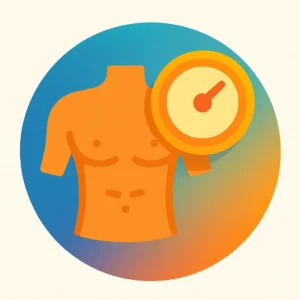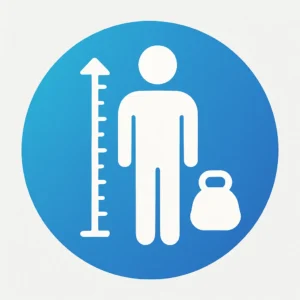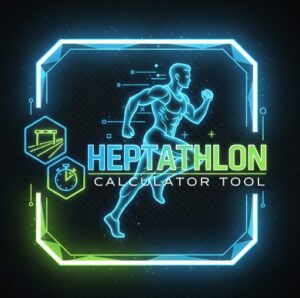Beep Test VO2 Max Calculator
Beep Test VO2 Max Calculator
Estimate your VO2 max from Beep Test results and get a personalized fitness rating.
Beep Test VO2 Max Calculator
The Beep Test VO2 Max Calculator is one of the most reliable ways to measure how efficiently your body uses oxygen during exercise. Whether you’re an athlete preparing for competition or a fitness enthusiast trying to track progress, this simple yet powerful test helps you understand your aerobic endurance. It gives you insight into your heart and lung capacity, which together define your overall fitness performance.
Many people underestimate how valuable VO2 max is. In fact, research published by the American College of Sports Medicine shows that VO2 max is one of the strongest predictors of cardiovascular health and athletic capability. This calculator allows anyone to measure it using just their Beep Test results — without needing lab equipment or expensive devices.
What Is VO2 Max and Why Does It Matter?
VO2 max refers to the maximum volume of oxygen your body can consume per minute per kilogram of body weight. The higher your VO2 max, the more efficiently your body can use oxygen during physical activity. This means you can run faster, train longer, and recover more effectively.
Think of VO2 max as your body’s “engine power.” Just as a car with a larger engine performs better under stress, a person with a higher VO2 max can sustain high-intensity exercise longer. It’s a key metric used by athletes, coaches, and sports scientists worldwide to assess endurance potential.
According to a 2022 study in the Journal of Sports Science & Medicine, elite male runners often have VO2 max scores above 70 ml/kg/min, while recreationally active individuals average around 45 ml/kg/min. The Beep Test VO2 Max Calculator Tool gives you a practical way to estimate your level within seconds.

Understanding the Beep Test
The Beep Test, also known as the multistage fitness test or shuttle run test, measures how far you can go before exhaustion. It consists of 20-meter sprints synchronized with timed beeps. As the test continues, the interval between beeps shortens, requiring faster running speeds.
Each stage in the test represents a “level.” Completing multiple shuttles within a level indicates a higher aerobic capacity. When you can no longer keep up with the beeps, your final level and shuttle count are recorded — and that data is what powers the Beep Test Calculator.
For example:
-
If you finish at Level 10 Shuttle 8, the calculator converts that score into a VO2 max value using scientifically validated formulas.
-
The higher your level, the higher your VO2 max.
This test is widely used by organizations like the police, military, and professional sports academies because it’s simple, accurate, and inexpensive.
How the Beep Test VO2 Max Calculator Works
The Beep Test VO2 Max Calculator Tool uses a well-researched equation developed by fitness scientists to estimate VO2 max based on your last completed level and shuttle count. You simply input:
-
Your Age
-
Your Gender
-
The Level you reached
-
The Number of shuttles completed
The tool then provides your estimated VO2 max (in ml/kg/min) and a corresponding fitness rating, such as Excellent, Good, Average, or Below Average.
You can easily try this on Ahmad Free Tools — the platform provides free, easy-to-use calculators for fitness and health tracking.
Real-Life Example: How the Calculator Helps
Let’s take an example of a 24-year-old male soccer player named Imran. He performs the Beep Test and reaches Level 11 Shuttle 6. When he enters his data into the Beep Test VO2 Max Calculator, his result shows a VO2 max of 52.8 ml/kg/min, rated as “Good.”
With this knowledge, Imran adjusts his training plan — focusing more on interval sprints and aerobic conditioning. After six weeks of structured workouts, he repeats the test and scores Level 13 Shuttle 2, boosting his VO2 max to 58.3 ml/kg/min, now rated “Excellent.”
This real-world progression demonstrates how this tool helps track measurable improvement.
Why You Should Use a Beep Test VO2 Max Calculator
Many people rely on wearables or gym equipment that only estimate VO2 max. However, the Beep Test VO2 Max Calculator uses an evidence-based method backed by decades of research. Here are key reasons to use it:
-
Scientific Accuracy: Based on validated performance formulas.
-
Accessibility: No equipment needed besides cones and an audio beep file.
-
Motivation: Quantifies progress, encouraging consistent training.
-
Personalized Insight: Adjusted for your age and gender for realistic results.
To complement your training, you can also check out other fitness tools like:
These additional resources work perfectly together to give you a complete picture of your fitness status.
What Your VO2 Max Score Means
Once you use the calculator, you’ll receive a score in milliliters of oxygen per kilogram per minute (ml/kg/min). Here’s a simplified breakdown of what your result indicates:
-
Excellent (60+ ml/kg/min): Elite athletic endurance
-
Good (50–59): Above-average fitness and stamina
-
Average (40–49): Decent aerobic capacity
-
Below Average (30–39): Room for improvement
-
Poor (below 30): Focus on consistent cardio training
For example, women typically have VO2 max scores around 10% lower than men due to physiological differences, but performance improvements follow the same progression pattern.
You can compare your result to fitness norms published by reputable sources like Top End Sports.
Factors That Influence Your VO2 Max
It’s important to understand that your VO2 max isn’t fixed — it changes with training, age, and lifestyle. Major influencing factors include:
-
Age: VO2 max tends to decline gradually after age 30.
-
Training Level: Regular aerobic exercise can increase VO2 max by up to 20%.
-
Genetics: Studies show genetics may determine up to 50% of your potential.
-
Altitude: People living at high altitudes often develop higher natural VO2 max values.
-
Health and Nutrition: Proper hydration, iron levels, and cardiovascular health affect results.
This means your score today doesn’t define your potential — it only reflects your current condition.
Experts’ Insight on VO2 Max and Beep Tests
Sports physiologists emphasize the importance of VO2 max as a measure of endurance. According to Dr. Stephen Seiler, a world-renowned exercise scientist, “VO2 max remains one of the best indicators of aerobic performance, but the real magic is in how consistently athletes train to raise it.”
Professional coaches also use the Beep Test Calculator as a benchmark for monitoring team progress. For example, in football academies, players’ Beep Test levels are tracked monthly to ensure endurance goals are met before tournaments.
Even in non-athletic populations, experts recommend periodic testing. The data can be a strong indicator of long-term cardiovascular health.
How to Improve Your VO2 Max Using Beep Test Results
Once you know your VO2 max through the Beep Test VO2 Max Calculator, the next step is to improve it. The great news is that VO2 max can increase significantly through consistent and targeted training. Let’s look at practical methods that athletes and trainers recommend for raising your aerobic capacity naturally.
Interval Training
High-Intensity Interval Training (HIIT) is one of the fastest ways to boost VO2 max. It involves alternating between intense effort and recovery periods. For instance, sprinting for 30 seconds followed by 90 seconds of slow jogging — repeated 8 to 10 times — helps your body adapt to oxygen stress. Studies from the European Journal of Applied Physiology confirm that HIIT can improve VO2 max by 15–20% within six weeks.
Endurance Training
Steady-state cardio, like cycling, swimming, or running at a moderate pace for 40–60 minutes, builds a strong aerobic foundation. Athletes often perform “long slow distance” sessions once or twice weekly to improve oxygen utilization efficiency.
Strength and Resistance Training
While VO2 max is mostly about cardiovascular endurance, research suggests that resistance exercises such as squats, lunges, and core stability training support better running economy. Stronger muscles require less oxygen during submaximal efforts, leading to improved endurance scores over time.
Active Recovery and Rest
Many people ignore the power of rest. Without recovery, your body cannot adapt and improve. Experts recommend one or two low-intensity days each week, including activities like yoga, brisk walking, or stretching.
Common Mistakes When Using the Beep Test VO2 Max Calculator
Even though the Beep Test Calculator is user-friendly, a few common mistakes can lead to inaccurate readings or misinterpretations. Understanding these can help you get more reliable results.
-
Incorrect Input: Entering wrong level or shuttle count can distort the calculated VO2 max. Always record carefully.
-
Poor Warm-Up: Starting the test cold can make you stop early, lowering your actual potential.
-
Uneven Surface: The test should be performed on a flat, non-slippery surface for accuracy.
-
Skipping Levels Too Fast: Rushing or missing beeps changes the intended rhythm of the test.
-
Not Accounting for Health Conditions: Those with respiratory or heart issues should consult a medical expert before testing.
Tracking Progress Over Time
The best way to make use of the Beep Test VO2 Max Calculator Tool is to test periodically and record results. By doing so, you can see how your training efforts affect your endurance capacity.
A recommended schedule is:
-
Test every 8 to 10 weeks
-
Maintain similar conditions each time (same surface, same footwear, similar time of day)
-
Log your data, including level, shuttle count, and VO2 result
Over a year, these records can clearly show how small improvements lead to big changes. Many coaches maintain VO2 max logs as part of athlete performance journals, ensuring that training adjustments are data-driven rather than guesswork.
Comparing Beep Test VO2 Max Results Across Sports
Different sports demand different levels of aerobic fitness. The following examples show how average VO2 max values vary by activity:
-
Professional Cyclists: 70–80 ml/kg/min
-
Elite Marathon Runners: 65–75 ml/kg/min
-
Soccer Players: 55–65 ml/kg/min
-
Recreational Runners: 40–50 ml/kg/min
-
Non-Athletic Individuals: 30–40 ml/kg/min
This variation highlights why the Beep Test VO2 Max Calculator is so valuable — it helps individuals from all fitness backgrounds benchmark their results against real-world standards.
For instance, if a 30-year-old recreational runner scores a VO2 max of 42 ml/kg/min, they can compare themselves to general population averages and set realistic performance goals.
Real Case Study: From Average to Excellent
A 29-year-old female named Sara began training for a charity marathon. Her initial Beep Test result placed her at Level 9 Shuttle 3, equivalent to a VO2 max of 39.5 ml/kg/min — an “average” rating.
Using insights from the Beep Test VO2 Max Calculator, she followed a personalized plan combining interval runs, cross-training, and proper nutrition. After three months, her new test result reached Level 12 Shuttle 1, lifting her VO2 max to 52.1 ml/kg/min. This shifted her fitness rating to “Good,” showing measurable, science-based improvement.
Sara’s progress is a great example of how consistent data tracking empowers self-motivation and long-term success.
How to Use the Calculator for Fitness Programs
The Beep Test VO2 Max Calculator Tool fits easily into a training routine. Here’s how you can apply it step by step:
-
Perform the Beep Test following standard 20-meter shuttle guidelines.
-
Note the final level and shuttle count.
-
Enter your age, gender, level, and shuttles into the calculator.
-
Record your VO2 max value and fitness rating.
-
Plan your training to improve on weak areas (e.g., aerobic conditioning, interval work).
-
Retest periodically to monitor progress.
For a holistic approach, you can combine it with other tools such as:
These interconnected resources provide a complete understanding of health, helping you maintain balance between endurance, strength, and overall well-being.
Expert Advice for Better VO2 Max Training
Fitness specialists emphasize that improvement takes time and discipline. Here are a few professional tips shared by sports coaches and exercise physiologists:
-
Start Gradually: Don’t jump into intense training without preparation. Build aerobic base first.
-
Mix Training Types: Combine long runs, tempo sessions, and sprint intervals for well-rounded endurance.
-
Track Resting Heart Rate: A lower resting heart rate usually means improved aerobic efficiency.
-
Stay Hydrated: Even mild dehydration reduces oxygen delivery efficiency during workouts.
-
Re-Test Regularly: Using the Beep Test VO2 Max Calculator every two months ensures accurate progress tracking.
Dr. Laura McMillan, a sports performance specialist, notes that “athletes who monitor their VO2 max regularly often sustain training motivation longer than those who don’t measure it at all.”
Safety and Precautions
While the Beep Test is safe for most people, beginners should take basic precautions before starting:
-
Consult a healthcare provider if you have cardiovascular or respiratory concerns.
-
Perform a light warm-up and stretching session before testing.
-
Ensure the surface is even and safe.
-
Stop immediately if you experience dizziness or chest discomfort.
Health professionals recommend using the calculator only after a complete test to ensure valid results.
The Science Behind VO2 Max Calculation
The formula used by the Beep Test VO2 Max Calculator originates from decades of sports physiology research. It correlates your final Beep Test level with oxygen consumption rates established in controlled laboratory environments.
By applying the equation:VO2 max = (3.46 × Continuous Level) + 12.2
The calculator provides an accurate estimation for both male and female participants. This equation has been refined through large-scale validation studies across multiple age groups, making it one of the most trusted field assessments available.
Conclusion
The Beep Test VO2 Max Calculator is more than just a number generator — it’s a practical, science-based way to understand your aerobic fitness and measure real progress over time. By applying your test results, you can track performance like professional athletes, identify weaknesses, and celebrate improvement with confidence.
Whether you’re training for competition or simply aiming for a healthier lifestyle, consistent use of this calculator gives you a clear roadmap to better endurance, improved cardiovascular health, and stronger motivation to stay active.
To explore more free fitness and health tools, visit Ahmad Free Tools — a trusted platform for accurate, user-friendly online calculators that help people achieve their goals naturally and effectively.
Frequently Asked Questions (FAQs)
Q1: How accurate is the Beep Test VO2 Max Calculator?
The calculator uses scientifically validated equations derived from controlled studies. While not as exact as lab tests, it provides a reliable estimation for practical use and consistent fitness monitoring.
Q2: How often should I take the Beep Test?
Experts suggest retesting every 8–10 weeks to track improvements while allowing enough time for meaningful progress between sessions.
Q3: Can beginners use this tool safely?
Yes. Beginners can use the Beep Test VO2 Max Calculator safely if they warm up properly and perform the test at their own pace. It’s always wise to consult a doctor before beginning any high-intensity training program.






